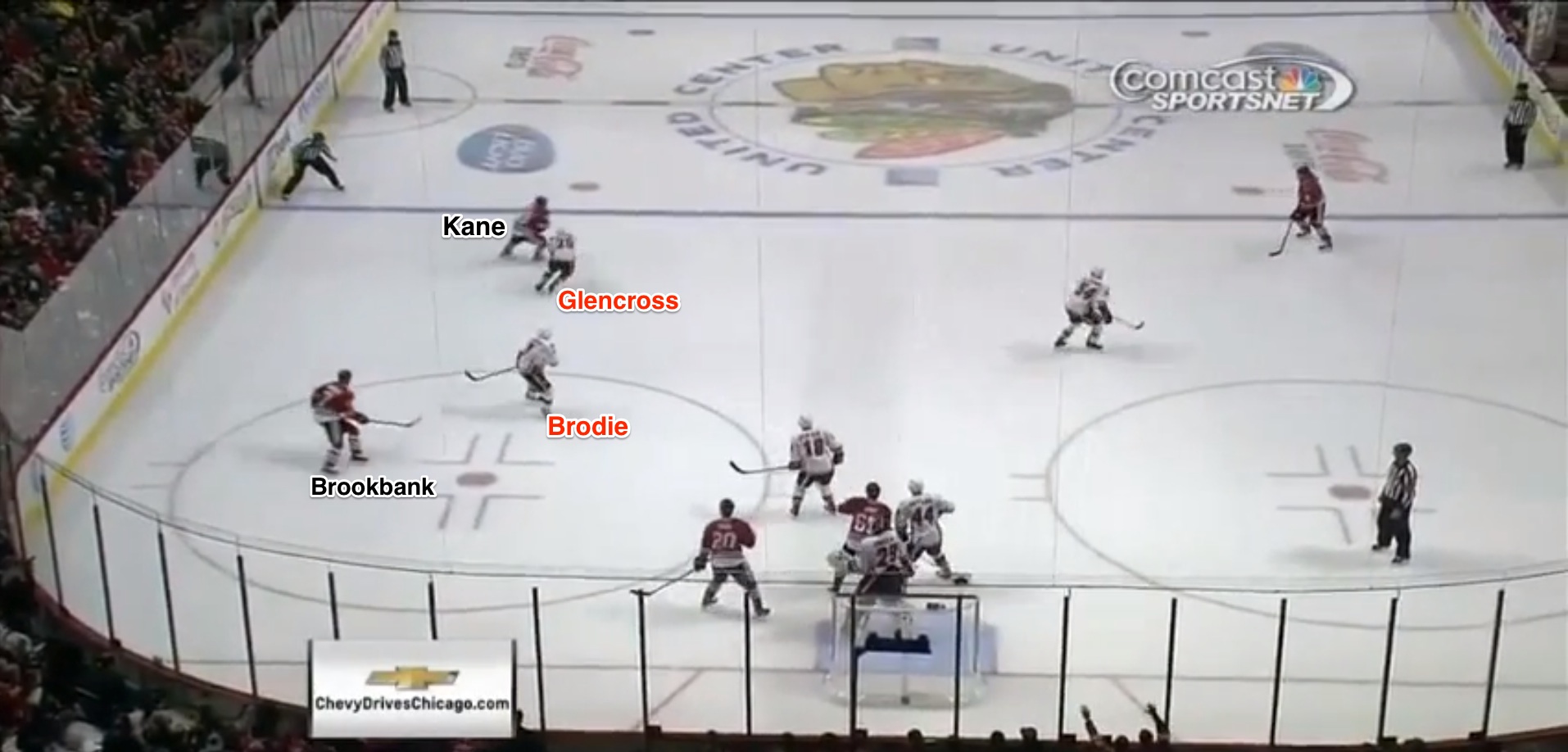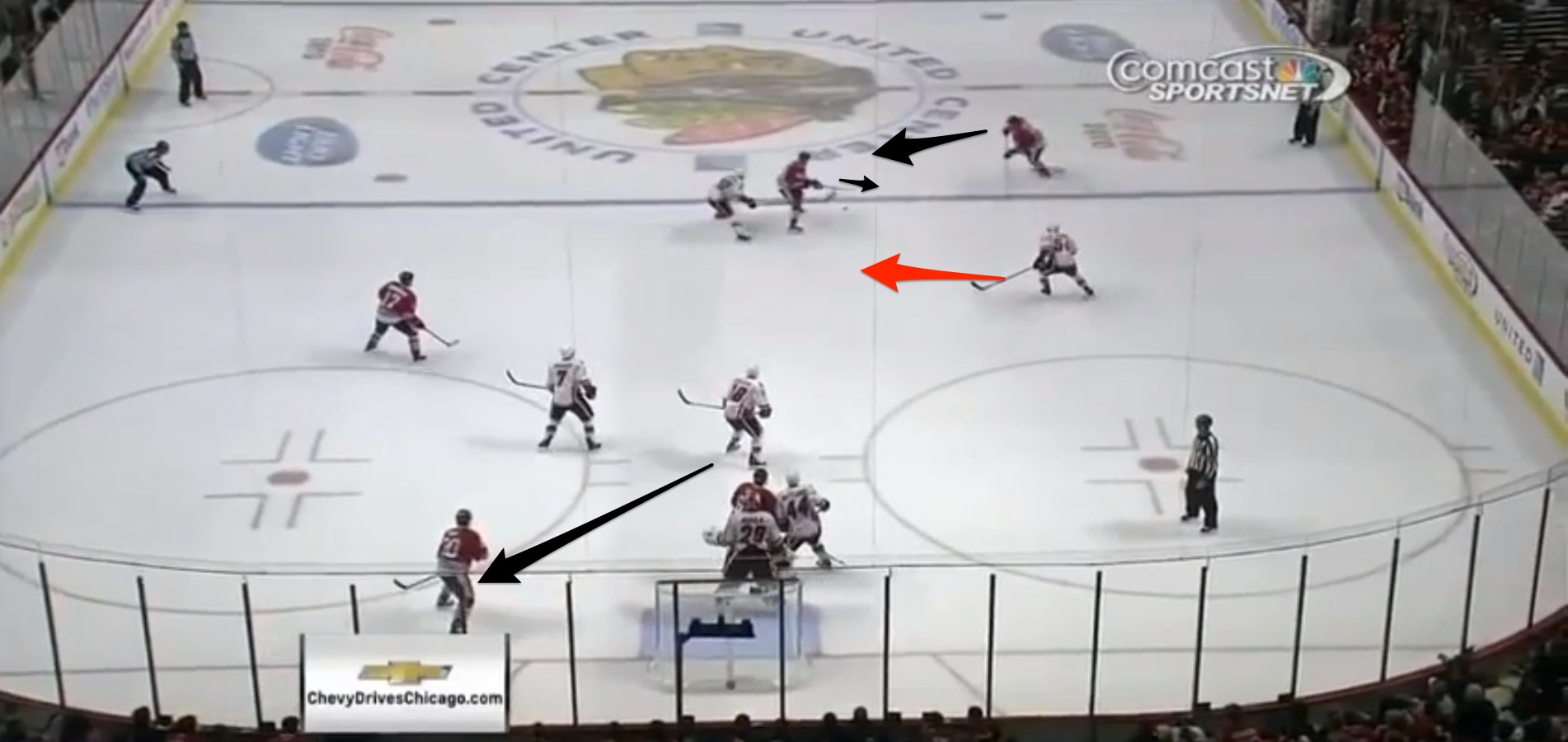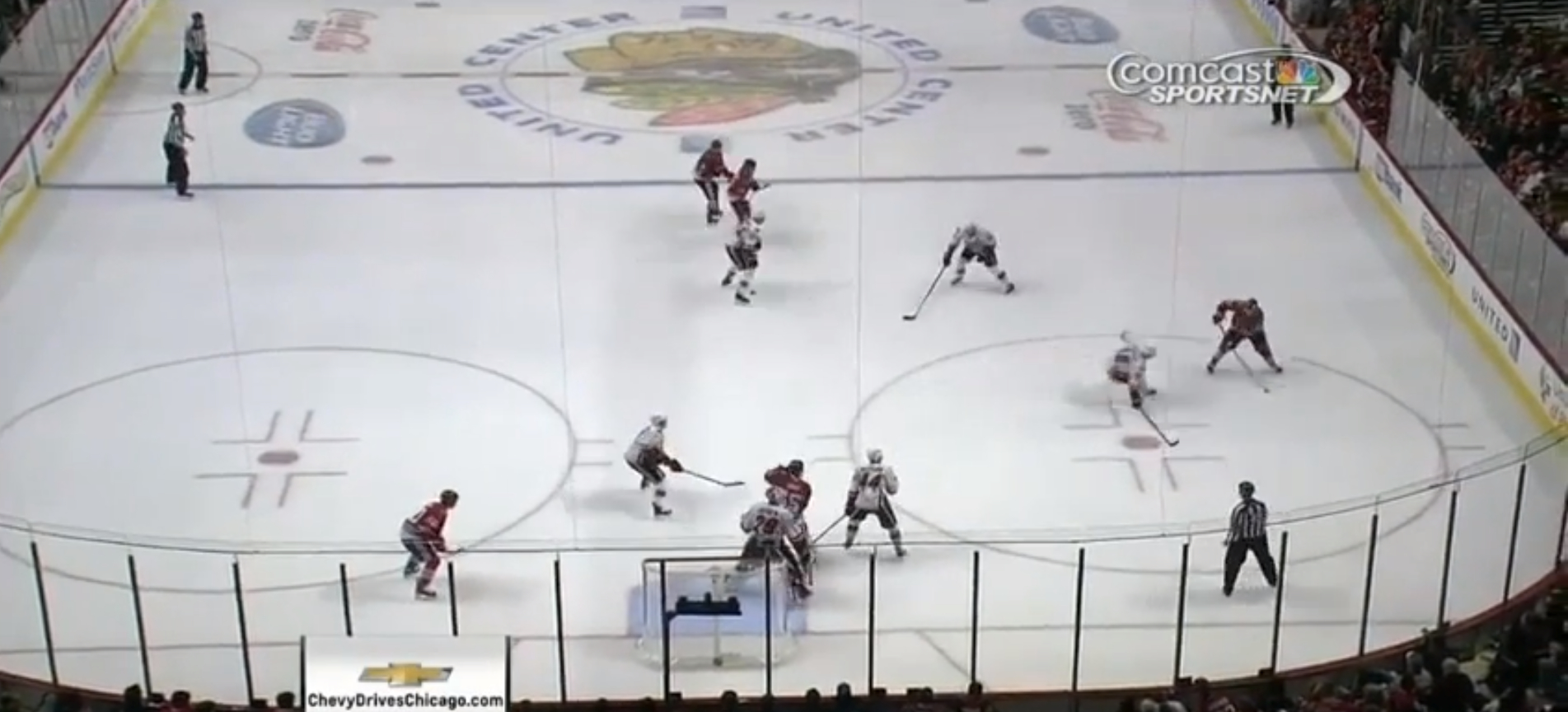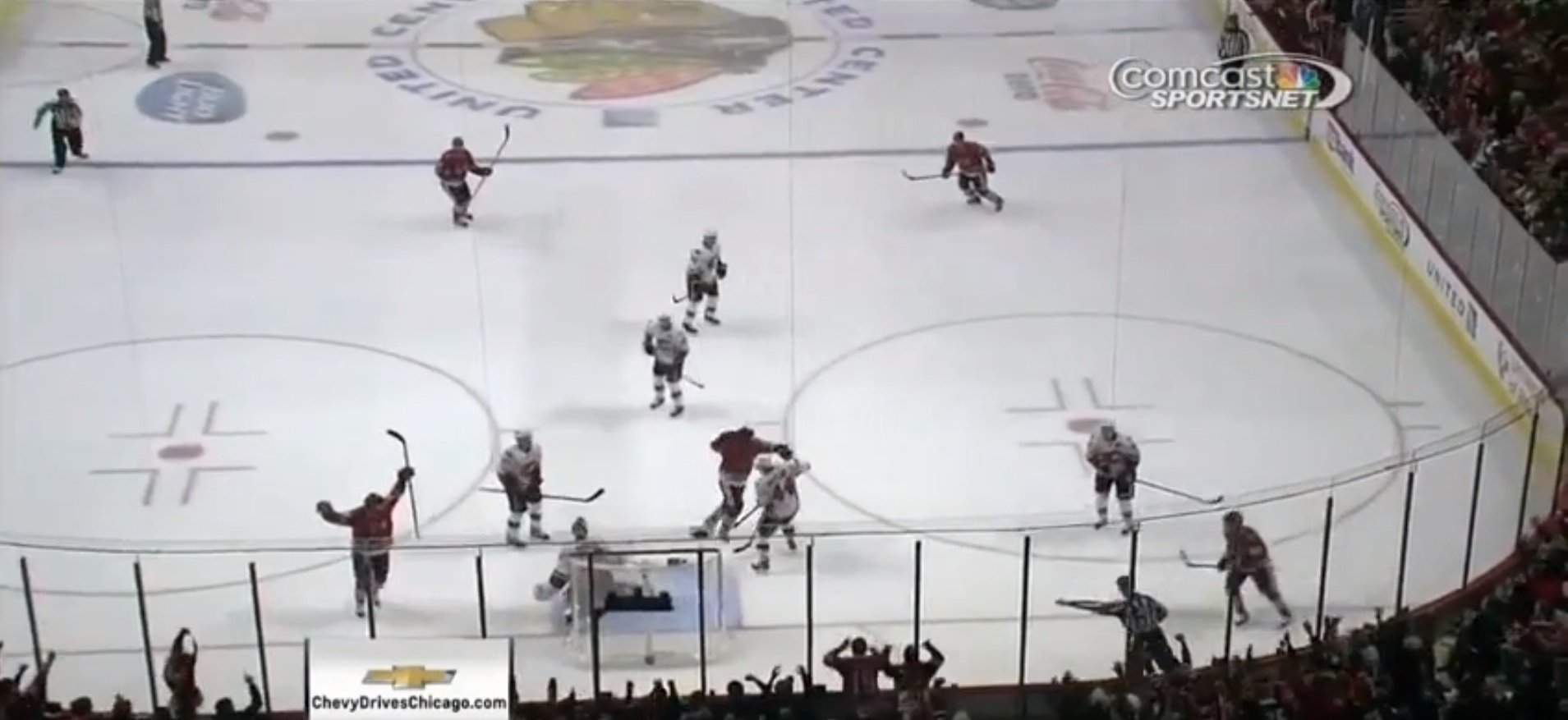Systems Analyst: How to properly defend an offensive scissor play
When the puck dropped to start the 2013-14 season, I can’t say I ever though I’d have to write these words in this order: yesterday the Calgary Flames beat the Blackhawks 3-2, in Chicago. Did not see that coming. Reto Berra won his first NHL game between the pipes, Kris Russel scored the OT winner and that was all she wrote.
There was one play that really stood out to me, and unfortunately for you, Flames fans, it wasn’t your team that scored. Nay, it was Patrick Kane, he of the ample puck possession time and curious wrist shot that put the Hawks up 1-0 to open the scoring.
It stood out to me because the Blackhawks executed a “double scissor,” which isn’t that difficult to defend, but every time you force the defense to make reads and switches, there’s a pretty good chance you’re going to open up an opportunity for yourself.
On this play in particular, Curtis Glencross demonstrates both the right, and wrong way to defend a scissor play.
Give it a look, then let’s discuss:
***
Here’s where we’ll start: Patrick Kane has solid possession of the puck in the corner. He’s being defended by TJ Brodie, while Curtis Glencross has his eye on Blackhawks’ defenseman Sheldon Brookbank. The Flames coverage is, to say the least, spot on in the frame below. Stajan’s on Shaw, Butler’s marked Saad, and Jones has sagged into perfect position in the slot as the weakside forward with Leddy up above him.
Muah. Perfecto.

Your one concern is that Patrick Kane has solid possession, and with skill players (or really, 90% of NHL-level players in general), you can’t run at them until they bobble the puck or they’ll burn you like a highschool kid does a notebook after graduating.
To create, Kane starts skating up towards Brookbank, which is his indication that Kane wants to run a scissor play. After all, it makes no sense to have two players in the same position on the ice, so if someone is coming to yours, you might wanna think about heading to where they’re coming from.
NOW. Brodie and Glencross have a choice, and yes, it is a choice. If they read this play early, the two can callswitch, and you end up in the admirable position of still having your defenseman low (as opposed to up near the blue line), and your forward high. The other option is to let the defenseman stay man-on-man, and have the forward play soft on the d-man (so as not to pick his teammate), but stick with him. The Blackhawks are hoping those two miscommunicate, or accidentally pick each other.

They nail it.
SWITCH!
Glencross is now on Kane.

Here’s where the Flames get confused down low, as can easily happen when the offense starts churning around the offensive zone like workout clothes on tumble dry. (I should note that the low confusion has eff-all to do with the goal, but still. We’ll note it for teaching purposes.)
But first, the issue up top. Patrick Kane is cutting across the top of the blue, and Nick Leddy sees him coming to his side. Again, that’s a pretty clear signal to run a scissor/swap places, so he runs behind Kane. This can serve as an offensive maneuver, and it’s fine defensively since Kane suddenly isn’t the last guy back if things go wrong.
Here’s the thing: Curtis Glencross is an offense-first kind of guy. He loves to score, he’s always thinking goal, and he senses a dangerous situation. Players tend to make poor drop-or-not decisions because the drop looks so pretty. If Kane decides to drop it to Leddy here, Glencross wants to sniff it out and head the other way on a partial breakaway (and you saw what he can do with those later in the game). I’m only guessing that’s his thinking, but frankly, I’m right. Otherwise there’s no excuse for the horrific angle and positioning on a guy when you’ve got the (shorter) inside track.
I’ve also tossed in an arrow because Matt Stajan has gone from what appears to be covering #65 to covering nobody. When Shaw gets in behind him, it might be a good idea to have a look around and see, hey, if I’m without a check, that open guy might be a good one to stand by.

But anyway, focus on the Glencross cheat up top, because leaning that way means Kane can use Leddy as a decoy and cut hard to the net.
David Jones executes his job perfectly. Glencross is clearly defending Kane, and from wing-to-wing, it makes no sense to call for a switch. It risks miscommunication, and the job is exactly same on either side for wingers, so whatever. Jones is soft on the play to allow Glencross to stick with Kane and…

Oh this isn’t good. Again, Jones does his job, but Glencross is toast. Now you have Patrick Kane coming at the net with full possession, and it gets even dicier.
Matt Stajan runs at him as he should here. Regardless of who you’re supposed to be covering, that’s a situation that needs addressing. You’re in full EVERYONE IN THE PANIC ROOM mode. That also means he’s abandoning Brandon Saad alone at the side of the net which isn’t good. Seeing this you’d like to see TJ Brodie recognize the danger and go and take him away, stat. Brodie probably shouldn’t stay covering a d-man who’s headed back to the point here, so it’s reasonable to suggest he should have looked for someone else low to cover to make the switch back to proper positioning.
He does start to fade back to get in that lane as Kane takes his shot, but something…something is off here.

When I first watched this goal, I tweeted this:
The hell was Reto Berra doing on that Kane goal? He looked like a soccer goalie guessing to the wrong side on a penalty.
— Justin Bourne (@jtbourne) November 4, 2013
And he did. One of two things happens here.
1) Berra has been aware of Saad’s presence on the backdoor the whole time (which would be good awareness, and not impossible considering the path Saad took to get there), and completely guesses that Kane is going to pass instead of shoot, or
2) The puck hits something (Butler’s pants?) on the way in.
Cause frankly, where Kane is shooting that puck from should not be a threat. Look in the picture below to see where Berra end up on a Kane shot that came from outside the dots on the other side:

Give it a watch again below if you like. Your main teaching takeaways for defending the scissor play should be this:
* On low-to-high scissors, it’s best if the d-man and forward can switch. If there’s no time to call switch, then the forward should play soft on the defenseman, then play low for awhile. He should be capable of that.
* On wing-to-wing scissors, stay with your guy, with the player defending the guy without the puck going beneath the pile to avoid picking his own guy.
The scissor play is just another way to make the defense make decisions, and in a quick game like hockey, it only takes a small mental gaffe to leave the rest of your teammates high and dry.